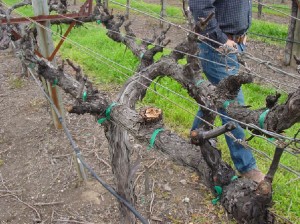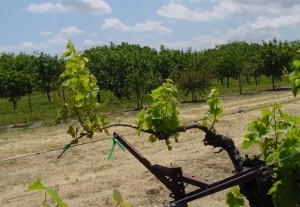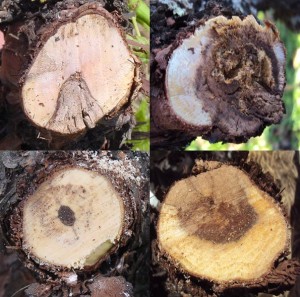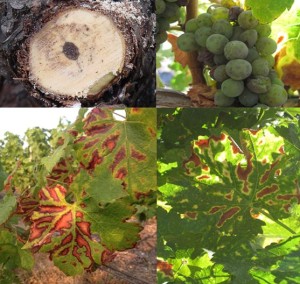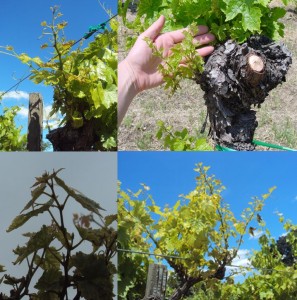Most vineyards in California are likely infected with trunk diseases (wood-canker). The main diseases are Botryosphaeria dieback, Esca, Eutypa dieback, and Phomopsis dieback. The infections are chronic and accumulate over time. Infected vines become less profitable with each additional infection, to the point at which the entire vineyard must be replanted. In this way, trunk diseases significantly limit vineyard longevity. Follow this guide to identify trunk diseases in your vineyard.
This Coffee Shop article was written by Kendra Baumgartner, PhD and Renaud Travadon, PhD, with grant funding from the USDA-NIFA Specialty Crop Research Initiative
__________________________________________________________________________________
Mark your calendars for the Managing Vineyard Trunk Disease Symposium on November 5th from 9AM-1PM at Burgundy Hall. Three hours of CDFA continuing education. Lunch will be served.
__________________________________________________________________________________
If you do have a trunk disease in your vineyard, it is not critical to identify the exact type because management practices are the same for all types and because trunk diseases typically occur in mixtures of several types. What is important is that you:
- Recognize trunk diseases as a problem,
- Understand the preventative practices,
- Adopt these practices in young vineyards,
- Do so on an annual basis throughout the life of the vineyard.
Do you have a trunk disease?
Look for these common symptoms, which are typical of all trunk diseases:
- Dead spurs (Figure 1)
- Stunted shoots (Figure 2)
- Wood symptoms (Figure 3 – a composite of four different-looking wood cankers, ranging from the quintessential pie-shaped canker to the black spots of Esca)
Esca and Eutypa dieback have specific symptoms, which are diagnostic of these two trunk diseases:
- Esca (Figure 4 – a composite of foliar symptoms on red and white cvs, fruit spots on a white cv, and concentric rings of black spots in a x-section of a cordon)
- Eutypa dieback (Figure 5 – a composite of stunted shoots with stunted leaves with tattered margins)
Botryosphaeria dieback and Phomopsis dieback do not have diagnostic symptoms. Instead, they are best characterized by the presence of one or more of the general symptoms listed above. That said, Phomopsis dieback is caused by the same causal pathogen of Phomopsis cane & leaf spot, which does have characteristic foliar symptoms. However, the relationship between foliar symptoms of Phomopsis cane & leaf spot and wood symptoms of Phomopsis dieback is not well understood. A vine can have one and not the other, which may be due in part to the fact that our Mediterranean climate is rarely conducive to foliar infections by the pathogen.
How to Prevent Trunk Diseases
Trunk pathogens attack primarily through pruning wounds with rain during the dormant season. Susceptibility to infection depends in part on when the pruning cuts are made. Pruning wounds made early in the dormant season (December) are more susceptible to infection in part because they can take weeks to ‘heal’. In contrast, pruning wounds made late in the dormant season (February) can heal within days, and thus can resist infection soon after pruning. There are no exact dates of high versus low susceptibility, mainly because rainfall patterns and climate change from year to year, and this affects not only the healing process of a pruning wound, but also the spread of the trunk pathogens. Regardless, what we can say with certainty is that the susceptibility of a pruning wound is highest at the start of the dormant season and declines as the growing season approaches.
Prevention of trunk diseases is focused on protecting pruning wounds. More often than not, vineyards are replanted before reaching their prime, either because no preventative practices are used or because they are adopted in a mature vineyard AFTER trunk diseases are widespread. What is critical is to start managing trunk diseases even in the absence of symptoms and in young vineyards. Prevent trunk diseases BEFORE symptoms appear.
What to do in Young Vineyards
It is imperative to start early prevention trunk diseases in young vineyards, and to do so every year. The infections are permanent and there are no curative practices. Do not wait until year 10. Once you see symptoms, it is too late for prevention. Preventing trunk diseases in a young vineyard is like teaching your kids to brush their teeth. Sure, the baby teeth fall out, but the reason we start 4-year olds brushing is so they have good habits before their adult teeth arrive.
It goes without saying that planting with clean nursery stock is an important means of ensuring the health of your vineyard. There are no requirements for nurseries to screen for trunk pathogens. Contaminated nursery stock has been shown in some studies to be a source of the causal pathogens of Botryosphaeria dieback, Esca, and Phomopsis dieback. Young vines may not withstand an infection like a mature vine, and weak growth in the first years of establishment may doom a vineyard to a lifetime of poor productivity. Indeed, Petri disease is a ‘version’ of Esca that affects only young vines. Providing the proper level of care for a young vineyard, in terms of sufficient irrigation and nutrition, may also be an important means of preventing trunk diseases. Certainly, Botryosphaeria dieback, Eutypa dieback, and Esca have been shown to have more detrimental effects on growth and yield when vines are both infected and under drought stress. Abiotic stress is thought to ‘trigger’ some of the trunk pathogens from simply living out a dull existence inside the wood to becoming an aggressive pathogen. There are two main approaches for preventing trunk diseases in young vineyards:
- Delay pruning until February. If you prune either by hand or mechanically, to spurs or to canes, schedule pruning in February and not in December. Double pruning is a type of delayed pruning, which is suited for cordon-trained, spur-pruned vineyards. It involves a first pruning pass, usually by a mechanical pruning machine, in December, which leaves canes that are approx. 8 or more inches in length. This is followed by a second and final pruning pass in February, which leaves the 2-bud spurs. In between the two passes, the trunk pathogens are unlikely to grow from the pruning wounds at the tips of the 8-inch canes down to the base of the cane.
- Prune in December and treat pruning wounds with a protectant for up to 1 month. Pruning-wound protectants that have been tested and are labeled for dormant-season use against trunk diseases are Topsin and Rally. Other pruning-wound protectants are currently under examination. Regardless of the pruning-wound protectant, if you prune in December, the protectant must be active from when you make the pruning cuts up to 1 month after pruning. The labeled pruning-wound protectants Topsin and Rally are not active for 1 month, and so more than one application is required. Also, they must be reapplied after rain.
What to do in Mature Vineyards
Adopting the practices listed above will not eradicate trunk diseases. However, they may minimize disease spread, reduce further infections, and thus maintain productivity more so than if you do nothing.
There are two approaches for managing trunk diseases in infected vineyards, in addition to the two preventative practices listed above:
- Sanitation. After pruning, gather the prunings and remove them from the vineyard or burn. Several trunk diseases can spread from infected canes (e.g., Botryosphaeria dieback), but their spores spread very short distances (up to 3 feet max). Therefore, if you remove the canes, you can reduce the numbers of spores.
- Surgery. Cut away infected cordons/ canes down to the trunk and retrain. The wood cankers are localized, and so if you cut them out, the plant is free of infection. This approach depends on cutting back far enough to where only healthy tissue remains. However, trunk pathogens are often present in healthy-looking parts of infected cordons/ canes, which is why our best advice is to recommend cutting all the way back to the trunk. This approach is labor-intensive and risky. It should be viewed an absolute last resort.
__________________________________________________________________________________


